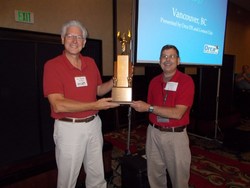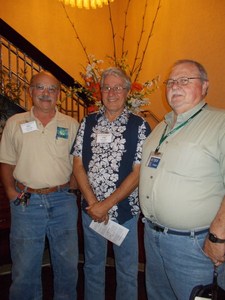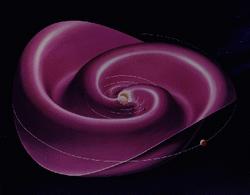 August 14, 2013 Editor: Ward Silver, NØAX | ||||||||
IN THIS ISSUE
NEW HF OPERATORS - THINGS TO DO Rookies - those licensed for three years or less - can put their talents to the test in the RTTY edition of the ARRL Rookie Roundup. For those of you mentoring new hams, they may find the digital modes a natural complement to day-to-day keyboarding. While you're at it - don't forget the multi-operator and team categories! BULLETINS The flurry of interest in W6ELProp created some access issues for downloading the software. Carl K9LA has made the current version (2.70) available for download on his website. (Thanks, Tad K7RA) BUSTED QSOS Nothing seriously out-of-whack in the last issue. CONTEST SUMMARY Complete information for all contests follows the Conversation section August 17-18
August 24-25
Ed WØYK, Larry K8UT, and Fred WW4LL are bringing back the Dayton RTTY Contesting Dinner in 2014 after a 10-year hiatus. With the assistance of Tim K3LR, the dinner will be held on Thursday night at the Crowne Plaza hotel in downtown Dayton. Watch the newsletters and websites for future announcements about tickets. The host committee of the 2014 World Radiosport Team Championship (WRTC) is pleased to announce that the application process for individuals Due to the generosity of volunteers, the AR Cluster V6 Telnet server at the Reverse Beacon Network (RBN) has just been replaced with a beta version that provides quality scores for each RBN spot, as well as filters enabling users to apply those scores to limiting the spots they receive. Note that if you don't set any of the new filters, the node will continue to function as it always has, except for the addition of a validity code as part of the comment on each RBN spot. All existing filters will continue to work as before. Read the full story on the AB5K website. Special thanks to CT1BOH, who did extensive analysis of RBN data anddeveloped the innovative algorithms being used, and to AB5K, for the hard work of coding and testing the filters for incorporation in this new version of his cluster software. (Thanks, Pete N4ZR) From QRZ.com, we learn that the latest version of the Amateur Data Interchange Format (ADIF) Standard, 3.0.4, has been approved by the ADIF Developer group. ADIF is a standard format used to exchange data between different Amateur Radio programs and websites. Amateur Contact Log 4.0 has been released, says author Scott N3FJP. The new software is a total rewrite of Amateur Contact Log and is fully networkable! The log can now be accessed from multiple PCs simultaneously at a home or club station acting as multiple clients updating a single database. Several of the EME groups on Facebook have come together to celebrate mentors who have guided EME beginners over the last 40 years, creating a web page to tell the story. The audio from several EME contacts can also be played back from the site. (Thanks, Jeremy W7EME)
Here's a good opportunity to get out and demonstrate ham radio while enjoying the summertime weather (for us northerners, anyway). The annual Lighthouse-Lightship Event isn't so much a contest as it is a special event - but there will be pileups, you may be sure! Event organizers report a record level of registration and along with many facilities hosting open houses, it's a chance to put ham radio where the people are. A reminder - with the ARRL September VHF Contest on the horizon, there are new categories that may be of interest to many hams. Todd KC9BQA has put together a nice web page explaining the FM-Only and 3-Band categories. Spread the word to your local general-purpose clubs and help get some new signals on the air! EDN Executive Editor Susan Deffree keeps the web page "Amateur and ham radio" up to date listing a number of EDN blogs and columns about ham radio. The latest, by Doug K1DG, is "What we need next in the evolution of ham gear" - lots of good reading to be found on the EDN website! Web Site of the Week - An interesting historical anniversary can be celebrated this fall as the CQ World Wide CW Contest begins just a few days before the
WORD TO THE WISE Say Thank You - yes, just like your Mom suggested, it is good manners to say thanks when you win a sponsored hamfest or convention prize. We all enjoy hearing our call sign at the raffle drawing - it's a fun aspect of many events and an important fund-raiser, as well. Take a moment to express appreciation to the person or company that donated the prize. Many vendors report that few winners express their appreciation - where are those manners? Grant KZ1W provided a link to a short online video showing how to do the "Figure 8 Flake" method of storing or spooling heavy cable, rope, hose, etc. Once you get the hang of it, so to speak, you'll find this method to be easy and effective. Your editor uses it all the time on ropes and large-diameter coax to keep them tangle and kink-free.
Check out the YouTube productions of Randy K7AGE - he's produced numerous "how-to" and other programs about basic ham radio and more advanced topics, too. These would be great at club meetings and training sessions. (Thanks, HamRadioNow by KN4AQ) You can "ride along" with Darryl WW7D as he recounts his ARRL UHF Contest rover adventures. Fans of Tektronix test equipment will enjoy the VintageTek website curated by Dennis Tillman. If you are a meteor scatter enthusiast, you might want to keep this XKCD cartoon "Guide to Meteor Showers" handy. Results for the 2013 CQ 160 Meter Contest are now posted on the contest website. To get your Log Checking Report (LCR) email your request to Contest Director, Andy N2NT. Please make sure to include your contest call sign, and the mode operated. After sorting out some database and log checking report (LCR) issues, the 74-page 2013 ARRL DX Phone extended results are now on line. Special thanks to the many regional and continental report authors! The Preliminary Results for the July 2013 running of the North American QSO Party on RTTY are now on the NCJ website. If you see any problems, please contact NAQP RTTY Contest Manager, Mark K6UFO. The Final Results will be published in the November/December 2013 issue of the National Contest Journal. Thank you to Bruce WA7BNM and Tree N6TR for making such prompt results possible, and to National Contest Journal for sponsoring the contests.
Beginning with the 2012 CQ World Wide RTTY Contest report, the complete score listings for all CQ contests are being published online only. To view the full score listing, visit the CQ Home Page at and click on the link under "Current Issue Highlights." (Thanks, CQ Communications Editorial Director, Rich W2VU) The 2012 Arizona Centennial QSO Party Results are in! Plaques and certificates will be sent out within the next month or so. If you are planning an operation in the 2013 AZ QSO Party, email the contest sponsors. (Thanks, Gary KE7DX) Bob WA1Z reports a new release of the Super Check Partial (SCP) database files is now available. The MASTER.DTA file has 43,868 calls and the MASTERRTTY.DTA file contains 11,746. (Maybe that's why 20 meters is so crowded - Ed.) OPERATING TIP As you undertake your pre-contest season shack cleanup, consider the layout of accessories such as switches and controllers. To minimize mental errors, the accessories should follow the general layout of the main radio equipment. If you use two radios during a contest, the accessories should be arranged in the same general way as the radios - left/right or above/below. For those of us with a shack located far from ground - such as on the second floor - RF "grounding" is impossible as even the shortest connection to the Earth has a significant electrical length. While a safety ground connection is something you need, managing RF voltage and current in the station takes on a new importance up in the air. Tom W8JI has put together some information about his above-ground installation on his website. (Thanks, John KK9A) If you wonder about the effectiveness of silver plating on connectors and are willing to read through a fairly comprehensive engineering report, this paper by Tyco Electronics is for you. (Thanks, Jerry W6UV) While there are a lot of electronic schematic editors, not many include tube symbols as part of their library of components. Bill KU8H found TubePad, a simple symbol-based editor built on the Paint accessory in Windows. Martin KH6MB, a Ko'olau Amateur Radio Club member, designed an antenna coupler for the club's Field Day operations at the north end of Kaneohe Bay. The coupler is used for bottom feeding two-element parasitic wire Yagis, half squares, or Bobtail Curtain antennas. The design matches several-thousand-ohm impedances to 50-ohm coaxial cable. (Thanks, Kimo KH7U) Gary W9XT recommends the 75-to-50-ohm matching trick of using alternating short sections of 50 and 75-ohm coax to match the cables over one band. This may be a better alternative at low frequencies where a half-wavelength may be a pretty long length of feed line. This EDN article discusses using several software tools for PC board layout and fabrication. A related Wikipedia article offers comparisons between many tools. Bob KØRC recently updated his VSWR charting tool and posted Revision 5 to the public Dropbox location. The new version allows you to chart both "before and after" VSWR curves to help visualize the effect of any adjustments you made to your antenna. You can print the charts for future reference.
Mark N1LO's web page on towers compiles a great deal of useful information on many tower-related topics. There are several other useful collections of information on his site, as well. (Thanks, Gene AD3F) LEDs have evolved rapidly over the past few years and it may be time for a refresher course in how to use the new designs. Filling that need, Don Tuite of Electronic Design wrote the informative "Understanding LED Application Theory and Practice" article in the May 2nd issue. Finding the right place to bypass a noisy ac line can be a time-consuming exercise. Tom W8JI used a three-wire ac plug with two 0.01 µF 250VAC UL/CSA bypass capacitors. No cord or wires were attached to the plug. Move the plug around the house from outlet to outlet and you may be able to find a "sweet spot" where conducted noise is reduced or eliminated. Follow Bill N3RR in the Potomac Valley Radio Club's July newsletter as he upgrades to become a competitive SO2R station. The same issue includes a bonus cartoon by K1NSS explaining the reasons "Why I Didn't Win the Contest" - we've all been there! Technical Web Site of the Week - The SVA (Single Vertical Phased Array) antenna designed by Floyd WA2WVL is described as being able to equal or exceed the performance of a Four-Square Array using only a single 39-foot aluminum mast. The front and back (top) guy wires, supporting the vertical, are used to create a 3-element endfire array. Only a single high-pass network is required to drive the front element (no quadrature network). Since the array is supported by a single lightweight 39 foot vertical, hinged at the ground, a single person can raise or lower the array. Flippin' Amazing The headlines scream, "Sun's Magnetic Field About to Reverse!" and suddenly every news anchor is a solar physics expert. Or not. The need of our 500-channel, 24/7/365 news machine to turn every story into a breathless cataclysm (so that you'll watch) is repeated with every solar flare and coronal hole - "Radiation from the Sun reaches Earth!" What's a ham to do? While the relentless over-hyping of relatively ordinary solar events gets pretty old this is actually a golden opportunity for contributions by hams to the ensuing discussion. How many of your friends and neighbors know about the ionosphere and Earth's geomagnetic field? Or about the solar cycle and sunspot dynamics? I'll bet not many. You don't have to be an expert yourself to add a little bit of sanity to the discussion.
You still need a story to tell, though. What I tell people is that when I'm on the radio, I can literally hear the world turning. That is what stops them in their tracks - not that I can talk to the Islets of Langerhan which they can do on via telephones or the Internet anytime from anywhere for free. Once they are interested, the conversation about what's really going on "up there" can begin. That hams can build and experiment and fool around with radio stuff is icing on the cake. While you have their attention, explain that the solar magnetic field gradually and slowly reverses right on schedule about every 11 years and has throughout history - with no ill effects. In addition, solar flares, even the big ones, generally have little effect. Is another Carrington Event of 1859 imminent? As last week's guest editorial writer and radio astronomer, Paul NA5N, notes, "This is the most boring solar maximum of my life time." Paul goes on to note via the QRP-L reflector, "When the Sun's fields reverse, there are known and measurable effects. The solar wind blowing out from the Sun is not a flat plane, but looks like a ballerina's skirt. The Earth is constantly traveling through the ripples of the skirt, which wiggles the Earth's magnetic field a bit...these are called boundary crossings. "As the Sun's magnetic field begins to reverse (over several months), the ballerina's skirt is constantly changing shape, sometimes triggering geomagnetic storms and auroras...During the "middle" of the solar reversal, the Sun's magnetic field strength at the poles gets very weak. The ballerina's skirt can get almost flat and very constant. For a few weeks, there will be very minimal solar activity, few flares, few CMEs, few coronal holes, etc...of course, with this solar cycle, who will notice that "lull" in activity?" I don't think we need to head for the bomb shelters any time soon. No responsible scientist is pushing an apocalyptic vision. By contrast, they are observing and measuring the Sun and its effects on our planet. For example, a recent story relayed by Robert Dehoney notes that by measuring the relative strength of reflections from the ionosphere, the upper atmosphere's temperature can be measured. In fact, you, can do radio science yourself as Eric KL7AJ describes in Radio Science for the Radio Amateur and in recent QST articles. All it takes is interest and attention to detail - we already have excellent receivers. You can build the necessary antennas, put an old computer to work, and - voila! - you're in the radio data collection business. Amateurs have made contributions through their observations in many fields through patience and consistency. Our constant experience with propagation is almost completely unique to ham radio among radio services available to private citizens. We have a completely novel way to interact with an unseen and rarely experienced aspect of the world around us. The ionosphere, tropospheric propagation, meteor scatter, moon bounce, grey line, dawn enhancement, backscatter, sporadic E, long path...hams can experience solar and geophysical phenomena every single day in a way most people will never know - and that's just flippin' amazing! 14 August through 27 August 2013 An expanded, downloadable version of QST's Contest Corral in PDF format is available. Check the sponsor's Web site for information on operating time restrictions and other instructions. HF CONTESTS ARRL Rookie Roundup--Digital, from Aug 18, 1800Z to Aug 18, 2359Z. Bands (MHz): 3.5-28. Exchange: Both calls, name, check, S/P/XE or "DX". Logs due: See web. Rules North American QSO Party--Phone, from Aug 17, 1800Z to Aug 18, 0600Z. Bands (MHz): 1.8-28. Exchange: Name and state. Logs due: 7 days. Rules http://ncjweb.com Dominican Republic Contest--Phone, from Aug 17, 0000Z to Aug 18, 2359Z. Bands (MHz): 3.5-7. Exchange: RS and serial. Logs due: Sep 2. Rules SARTG WW RTTY Contest--Digital, from Aug 17, 0000Z - See website. Multiple time periods. Bands (MHz): 3.5-28. Exchange: RST and serial. Logs due: Oct 10. Rules Russian District Award Contest--Phone,CW, from Aug 17, 0800Z to Aug 18, 0800Z. Bands (MHz): 1.8-28. Exchange: RS(T), serial or Russian district. Logs due: 30 days. Rules Keymen's Club of Japan Contest--CW, from Aug 17, 1200Z to Aug 18, 1200Z. Bands (MHz): 1.8-28, 50. Exchange: RST and JA pref/dist or continent. Logs due: Sep 21. Rules Feld-Hell Gridloc Sprint--Digital, from Aug 17, 2000Z to Aug 17, 2200Z. Bands (MHz): 1.8-28. Monthly on 3rd Saturday. Exchange: RST, S/P/C, Feld-Hell nr, 4-char grid square. Logs due: 7 days. Rules SARL Digital Contest--Digital, from Aug 18, 1300Z to Aug 18, 1630Z. Bands (MHz): 3.5-14. Exchange: RST and serial. Logs due: 7 days. Rules Run For the Bacon--CW, from Aug 19, 0100Z to Aug 19, 0300Z. Bands (MHz): 1.8-28. Monthly on 3rd Sunday night (local). Exchange: RST, S/P/C, Flying Pig nr or power. Rules ALARA Contest--Phone,CW, from Aug 24, 0400Z - See website. Multiple time periods. Bands (MHz): 3.5-28, 144,440. Exchange: RS(T), serial, ALARA nr, name. Logs due: Sep 30. Rules Hawaii QSO Party--Phone,CW,Digital, from Aug 24, 0400Z to Aug 26, 0400Z. Bands (MHz): 1.8-28. Exchange: RS(T) and Hawaii multiplier or S/P. Logs due: Oct 1. Rules YO DX Contest--Phone,CW, from Aug 24, 1200Z to Aug 25, 1159Z. Bands (MHz): 3.5-28. Exchange: RS(T), serial or YO district. Logs due: 30 days. Rules SCC RTTY Championship--Digital, from Aug 24, 1200Z to Aug 25, 1159Z. Bands (MHz): 3.5-28. Exchange: RST, 4-char year first licensed. Logs due: Sep 15. Rules Kansas QSO Party--Phone,CW,Digital, from Aug 24, 1400Z - See website. Multiple time periods. Bands (MHz): 3.5-28, 50,144, CW--40 kHz above band edge; Phone--3.840, 7.240, 14.240, 21.340, 28.440 MHz. Exchange: RS(T) and KS county or S/P/"DX". Logs due: Oct 1. Rules Ohio QSO Party--Phone,CW, from Aug 24, 1600Z to Aug 25, 0400Z. Bands (MHz): 3.5-28. Exchange: Serial and S/P or "DX". Logs due: 30 days. Rules South Africa DX CW Contest--CW, from Aug 25, 1300Z to Aug 25, 1630Z. Bands (MHz): 3.5-14. Exchange: RST and serial. Logs due: 7 days. Rules VHF+ CONTESTS ARRL 10 GHz and Up Contest--Phone,CW,Digital, from Aug 17, 6 AM to Aug 18, 12 AM. Bands (MHz): 10G+. Exchange: 6-character grid locator. Logs due: Oct 19. Rules Keymen's Club of Japan Contest--CW, from Aug 17, 1200Z to Aug 18, 1200Z. Bands (MHz): 1.8-28, 50. Exchange: RST and JA pref/dist or continent. Logs due: Sep 21. Rules ALARA Contest--Phone,CW, from Aug 24, 0400Z - See website. Multiple time periods. Bands (MHz): 3.5-28, 144,440. Exchange: RS(T), serial, ALARA nr, name. Logs due: Sep 30. Rules Kansas QSO Party--Phone,CW,Digital, from Aug 24, 1400Z - See website. Multiple time periods. Bands (MHz): 3.5-28, 50,144, CW--40 kHz above band edge; Phone--3.840, 7.240, 14.240, 21.340, 28.440 MHz. Exchange: RS(T) and KS county or S/P/"DX". Logs due: Oct 1. Rules LOG DUE DATES 14 August through 27 August 2013
ARRL Information Click here to advertise in this newsletter, space subject to availability. Your One-Stop Resource for Amateur Radio News and Information ARRL membership includes QST, Amateur Radio's most popular and informative journal, delivered to your mailbox each month. Subscribe to NCJ - the National Contest Journal. Published bimonthly, features articles by top contesters, letters, hints, statistics, scores, NA Sprint and QSO Parties. Subscribe to QEX - A Forum for Communications Experimenters. Published bimonthly, features technical articles, construction projects, columns and other items of interest to radio amateurs and communications professionals. Free of charge to ARRL members: Subscribe to The ARRL Letter (weekly digest of news and information), the ARES E-Letter (monthly public service and emergency communications news), Division and Section news -- and much more! ARRL offers a wide array of products to enhance your enjoyment of Amateur Radio. Visit the site often for new publications, specials and sales. Donate to the fund of your choice -- support programs not funded by member dues! Reprint permission can be obtained by sending email to permission@arrl.org with a description of the material and the reprint publication. ACKNOWLEDGEMENTS ARRL Contest Update wishes to acknowledge information from WA7BNM's Contest Calendar and SM3CER's Contest Calendar. | ||||||||
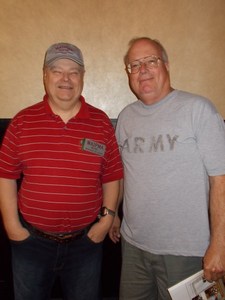
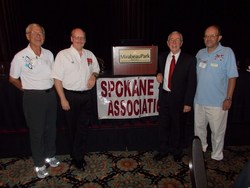
.jpg)
